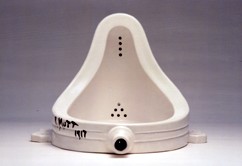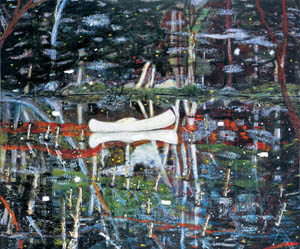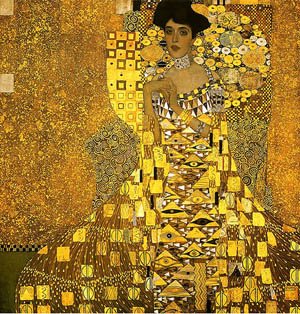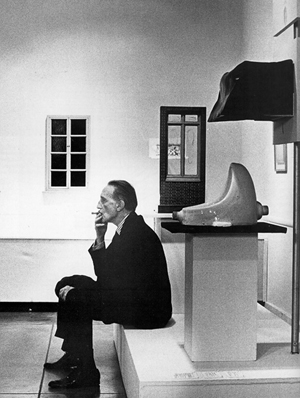
|
||
|
Portland art blog + news + exhibition reviews + galleries + contemporary northwest art
|
||
The Fountainhead
Posted by Jessica Bromer on February 27, 2007 at 22:33 | Comments (4) Comments I may be the only artist in Portland that somewhat likes these ridiculously high art values. It keeps art a dream. An untouchable object. However, I recognize that this aspect and practice of the art world then excludes much of the general public, and even the artists that create work. Most artists are not able to pay their own gallery prices for their work, let alone another artist's work. But I think is is not always a negative. I think purposely excluding people can sometimes lead to a small, richer community. It's a marketing thing. Say you are in a band, and you hate Metallica (as any good person should). Let the public know that you hate Metallica and you exclude some people, but the people that share your opinion begin to relate closer to the music that you create. In other news, I love it that so many people have tried pissing in "Fountain." I think Duchamp might appreciate the act's absurdity. Posted by: Calvin Ross Carl I'm troubled that I found Kimmelman's talk more problematic than the attack on the urinal. The urinal is an object of intended deflections that has been both undermined and supported by its own successes and failures in "the deflection department." (Including deflecting blows from hammers or streams of urine.) I found Kimmelman entertaining to the point of mild irritation. The irritation comes from the fact that I'm definitely not his audience. He's writing for people who dont have a lot of experience, which is fine, but I also felt he was courting the less experienced or less critical audience with some really standard arguments.... I wanted more rhetorical teeth... I can tell he has something to offer intellectually but I feel he holds back. Is he saving it for a book? I expect more from the NYT's and it's why the last major thing Ive read and liked by him was the Michael Heizer piece. I read his Erwitt review days before the lecture and felt I got more from reading a press release or looking at an internet photo. The Erwitt show at PAM itself was obviously the most rewarding and I like that part of Kimmelman's message. Too obvious. Kimmelman can certainly write and is full of (necessary) paradoxes but in the end he doesnt seem to challenge his audience as much as play to their insecurities. Is Kimmelman a gifted flatterist?... most good writers are but does he go much beyond that? The value on the Doig was too easy a shot... of course it isn't worth more than 500,000 but by selling for 11 big ones it perceptually made 500,000 acceptable... if the hedge funder who bought it owns 50 other Doigs which he bought for 20,000 a piece he just made a mint by overpaying and raising the overall value of his other Doig holdings 5 fold. It's a pretty obvious market manipulation. The Klimt is worth the 135 million, it's historically significant in ways few Americans understand. The Bloch-Bauer portrait is of a woman whose cultural importance was vast... like Gertrude Stein (kimmelman neglected to mention that). Now that Klimt has accumulated all of that positive historical baggage... something the Doig hasn't even made pretensions of having (and it cant, Doig isn't amongst a bunch of relevant intellectuals). I like Doig though; he's a good painter and 50 years from now that painting might be worth 2 million... wheras the best Hirsts might be worth 40 million plus (that it including inflation). Why? Hirst owns his own market and issues of the day in a way that Duchamp also did (making later versions of the urinal, just as Hirt is making new sharks while refurbishing the original). Only Murakami could claim equal if not superior importance in contemporary art (the constant comparisons are good for both of them). Yes the market is crazy... but Im over it, I think it's a nice way to show how rich the rich have become and to help everyone understand the scale of that situation. I just wish there was more great art being produced. So Rachel Harrison clones beware, the original is what survives history. Posted by: Double J I was the first person to franticly raise my hand after Kimmelman finished his talk and invited question. To paraphrase is ask "Considering how media obsession with the money in art alienates so much of the public, how can you as a critic, us as institutions, businesses, and communities in volved with the arts make the case that art is relivant to the average person?" His initial response was "I don't want to give the impession that the money in art is bad, it is what it is." Then he danced around the topic for a few minutes until he simply suggested we disregard the hype and find our own personal connections to art. From my perspective he acknowledges that the world of high art has degenerated into a small group that knows the price of everything and the value of nothing. Yes, it is about the money, or more accurately it's about the people buying and selling the art instead of the work. All this was documented quite elequently, with scathing honesty by Alice Goldfarb Marquis in her book "The Art Biz". The book is out of print now probably because the people invovled with the maket making side of the art business fear that amount of transparency into the world they control. Ironicly, the transparency Marquis offers in her book is an important part of the answer to my question. The media hype the stories about the high prices select pieces of art command at auction without making any attempt to explain why the price is so high. The average person reads about a 19th century landscape that sells for 35 million dollars to the Walmart heir and they tell themselves "I'll never be able to buy a great piece of art." Galleries regularly receive calls from people asking about the admission price for the current show. The reality is that fine art is really only marketed to the top 10% of the population in this country. Most of the people are left out of the conversation. I'm not saying that the Visual Arts pages in newspapers and the glossy "ArtNews" type magazines don't have there place; but these are trade rags and not meant for the general public. Sadly, there is virtually nothing written for the majority of people who never got that fine arts degree, weren't born into a privilaged family and are stuck on the lower rungs of understanding about art and aesthetics. Think about how much of the arts have been cut from our public school over the last 30 years. The media and the arts community do a great job of advocating for the artist, but there is no attemp to advocate for the audience, i.e. the prospective new buyer. I don't believe you can SELL a piece of art, art sells itself. Once the artist has put a work up for sale to the public it is now longer about the artist or the venue in which it is sold, it's about the person who looks at the piece and the connection that transpires. The thing that you can and must sell to the perspective buyer is the idea of buying art for the personal connection the viewer makes with a piece and how this process helps the viewer connect more meaningfully with the world they live in. There in lies the true value of art as Kimmelman inplied in his talk. I agree with Kimmelmen in the way he approaches laying out what the problem of created by the obsession we have with the money in art, but I insist that we can do more than simply ignore the hype. We can start building a conversation that invites a larger audience into the world of art. I have always believed that the best way to advocate for artists is to create more buyers. Posted by: Duane D. I think he was avoiding a question that he himself cant answer very well. I dont think the art mags have much influence either and they generally do an allright job of disseminating why some art is worth millions. Most mags actually avoid the issue, that's a job for daily investigative news sources. My issue with Kimmelman is he could do a lot more but he opts out to have a bunch of art travelogues... which has its place but I sense he's giving the art industry a hall pass so he can make easy critiques of it. It would be more valuable if he gave it a bit more work justifying itself. The general media, especially TV and newspapers seem to be the ones most focused on the dollar signs and it's one of my biggest critiscisms of the O (the focus on money while being so one dimensional it turns off potential patrons to the discussion somewhat). By simply following the money it misses the point... for example Ken Eunkles was not on the recent "most influential" list. The man's contribution to the scene as a major art studio space provider is incalculable (more than anyone on that list he makes Portland "Portland" and nobody on the list would argue it)... Just think, Matt McCormick, Joe Thurston, Jacqueline Ehlis and hundreds of others all pay him rent... yes that's money but not in a big lump sum way the general media finds sexy enough for such a list. Years ago they focused on him but now, when hes even more important it isn't big ticket enough. Now David might agree with me about Ken even but by making an article a poll the O was washing its hands of making a judgement. Everyone who really cares about art wants highly considered coverage not justifications for sensationalized sentiment. The general audience just wants to point at fools parting ith their money. The truth is money is fine... it takes all levels and the art world is full of strata... it isnt bad either... some is affordable some isnt... big deal. What really matters is what survis 50 years from now and that takes thughtful consideration. I even think Hirst exploit the dollar blindness of the general media and I think thats why a small group of very rich collectors support him... the most famous of which, Saatchi is an Ad man who understood that by making the media look and act like jackasses his artists would become their antipode.... and important. Still, until the generalist media in the USA stops being the mouthpiece of anti-intellectual sentiments and a purveyor of cheap shock tactics (92% of the time) we will be forced to go to specialty media for info. Yes, the newspapers are feeling threatened by blogs but it's their own fault... and probably due to the ownership models of big media. Most journalists have a tough time doing what they really would like to do. PORT itself is blog in format only... it's more of a critical journal and a coffeehouse discussion than a personal outlet. We do this because it's important.
Posted by: Double J Post a comment Thanks for signing in, . Now you can comment. (sign out)
(If you haven't left a comment here before, you may need to be approved by
the site owner before your comment will appear. Until then, it won't appear
on the entry. Thanks for waiting.)
|
| s p o n s o r s |
 |
 |
 |
 |
 |
 |
 |
 |
 |
 |
 |
 |
 |
 |

|
Site Design: Jennifer Armbrust | • | Site Development: Philippe Blanc & Katherine Bovee | |







![[TypeKey Profile Page]](http://www.portlandart.net/nav-commenters.gif)